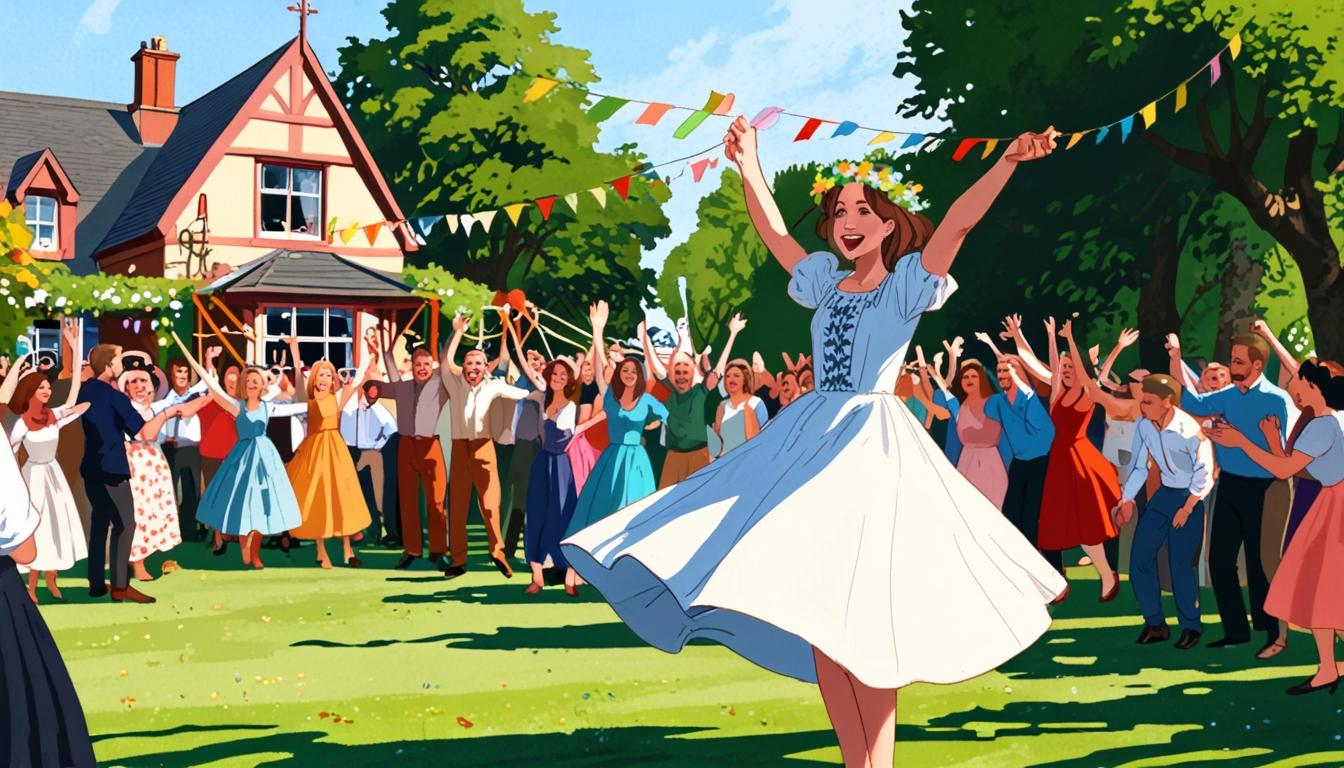Once marked by widespread closures and police on high alert over Mods and Rockers unrest, May Day in Aberdeen has evolved into a vibrant blend of cultural festivities, community fundraising, and social activism, reflecting the city’s rich heritage and contemporary concerns.
In days gone by, May Day was an almost universal holiday across the north-east of Scotland, drawing throngs of visitors to Aberdeen, particularly when blessed by favourable weather. This celebration was marked by a shutdown of shops, schools, and offices throughout the region, creating a significant sense of community and festivity. Towns like Turriff and Banff typically enjoyed an extended break, allowing residents to participate in various local activities without the constraints of work.
Historically, events like the May Day fayre at Queen’s Links were pivotal in raising funds for local charities, fostering a spirit of goodwill and communal support. However, the cultural landscape of May Day was not without its tensions. In 1980, extra police presence was deemed necessary amid fears of unrest from the Mods and Rockers subcultures. Authorities anticipated an influx of these groups, reflective of the longstanding tensions between them, which had flared in past decades. As roads into Aberdeen were monitored for incoming biker gangs, the city braced for potential disturbances during the festivities.
Despite the heightened security measures, including the cancellation of a much-anticipated performance by the band Madness, May Day passed with relative calm. Although around 10,000 people attended the fayre, reports indicated only minor disturbances. Police engaged in a “steady cat-and-mouse game” with groups of teenagers congregating in various locations, successfully keeping serious conflict at bay. The day ended on a positive note, with community events such as a ladies’ football final that saw Aberdeen Ladies FC take on Tillydrone Ladies, ultimately raising £4000 for an electrocardiograph machine for Aberdeen Royal Infirmary.
Today, May Day remains a significant date on the calendar, with contemporary celebrations reflecting both a festive spirit and social activism. Recent events, such as the May Day march organised by the Aberdeen Trades Union Council, focus on pressing community issues, including cuts to essential public services. This rally drew participants from across the region, united in their efforts to safeguard vital resources for children and vulnerable populations. The march, which made its way down Union Street to a concluding rally at Castlegate, epitomised the evolving character of May Day in Aberdeen—transforming from a day primarily of celebration to one that can also serve as a platform for community advocacy.
Meanwhile, local establishments continue to embrace May Day as an essential social occasion. Venues in the city, such as Revolution on Belmont Street, become vibrant hotspots, drawing locals and visitors alike. Partygoers often describe the atmosphere as electric, full of energy and music, and indicative of a thriving community scene. Interviewees, including Abby Ross from Turriff, express appreciation for the lively events and the sense of camaraderie fostered through shared celebration.
The roots of May Day run deep, tracing back to ancient traditions. Originally a festival linked to the Roman goddess Flora and celebrated during the Floralia, May Day evolved over the centuries. In Celtic lore, it became associated with fertility and spring, particularly through the Beltane festival, which highlighted the importance of nature’s cycles. This historical backdrop enriches the current celebrations, linking modern festivities to a vibrant tapestry of cultural heritage. Additionally, the rise of the May Queen and traditional maypole dancing exemplify how these rituals have persisted, adapting to contemporary contexts while preserving their festive essence.
As May Day approaches each year, it serves as a reminder of the intricate interplay between celebration and community, tradition and modernity. The festival has blossomed from its historical origins into a multifaceted occasion that blends joy with activism, ensuring that it remains a defining aspect of life in Aberdeen.
Reference Map
- Paragraph 1: 1
- Paragraph 2: 1
- Paragraph 3: 1, 2
- Paragraph 4: 2, 3
- Paragraph 5: 4, 5
- Paragraph 6: 4, 6
Source: Noah Wire Services
- https://www.pressandjournal.co.uk/fp/past-times/6733389/photo-gallery-may-archive-photos-aberdeen/ – Please view link – unable to able to access data
- https://www.pressandjournal.co.uk/fp/news/aberdeen-aberdeenshire/5661946/may-day-march-rally-aberdeen/ – This article discusses a May Day march and rally in Aberdeen, organized by the Aberdeen Trades Union Council. The event aimed to protest cuts to essential public services, including library and leisure facility closures. Participants gathered on Rubislaw Terrace, marched down Union Street, and concluded with a rally at Castlegate. The article highlights the community’s efforts to protect vital services for children and vulnerable populations, emphasizing the importance of public facilities in maintaining a decent society.
- https://www.pressandjournal.co.uk/fp/lifestyle/food-and-drink/5672380/may-day-in-aberdeen-what-punters-said-about-the-celebrations/ – This piece captures the vibrant atmosphere of May Day celebrations in Aberdeen, focusing on the experiences of partygoers at local venues like Revolution on Belmont Street. The article features interviews with attendees, such as Abby Ross from Turriff, who praises the event’s music selection and energetic DJs. It provides insights into the city’s festive spirit, highlighting the significance of May Day as a major social event for both locals and tourists, with venues bustling from early afternoon.
- https://www.nationaltrust.org.uk/discover/history/the-history-of-may-day – This article from the National Trust delves into the origins and evolution of May Day celebrations. It traces the festival’s roots from ancient Roman times, highlighting the Floralia festival dedicated to Flora, the goddess of flowers. The piece also explores the transformation of May Day into a celebration of spring and fertility in Celtic regions, particularly focusing on the Beltane festival in Scotland. Additionally, it discusses the rise of the May Queen figure and the tradition of maypole dancing, emphasizing the cultural significance of these practices.
- https://www.theguardian.com/travel/2005/may/01/unitedkingdom.culturaltrips.observerescapesection1 – This article from The Guardian provides a brief history of May Day, tracing its origins from a pagan holy day celebrating spring planting. It discusses how the Celts and Saxons celebrated 1 May as Beltane, involving torch-bearing peasants climbing hills and igniting wooden wheels. The piece also covers the evolution of May Day into a popular feast day for medieval craft guilds, its suppression by the Catholic Church in the 1600s, and its association with workers’ rights in the United States in 1886.
- https://en.wikipedia.org/wiki/May_Day – This Wikipedia article offers a comprehensive overview of May Day, detailing its origins, historical significance, and various cultural celebrations worldwide. It covers the festival’s roots in ancient Roman and Celtic traditions, its evolution into International Workers’ Day, and its diverse observances across different countries. The article also discusses the Maypole tradition, the role of the May Queen, and the impact of May Day on labor movements, providing a global perspective on this annual celebration.
- https://en.wikipedia.org/wiki/Mods_and_rockers – This Wikipedia article explores the Mods and Rockers subcultures in Britain during the late 1950s to mid-1960s. It details their fashion, music preferences, and the conflicts that arose between them, particularly the media-fueled moral panic following riots in seaside towns in 1964. The article also touches upon the resurgence of these subcultures in the 1980s, including the mod revival and associated tensions, providing historical context to the cultural dynamics of the time.
Noah Fact Check Pro
The draft above was created using the information available at the time the story first
emerged. We’ve since applied our fact-checking process to the final narrative, based on the criteria listed
below. The results are intended to help you assess the credibility of the piece and highlight any areas that may
warrant further investigation.
Freshness check
Score:
6
Notes:
The narrative includes historical context and recent events, suggesting a mix of dated and contemporary information. Specific recent events like the May Day march are mentioned, but without precise dates, which slightly reduces the freshness score.
Quotes check
Score:
5
Notes:
There are no direct quotes that could be verified online. This lack of verifiable quotes does not necessarily imply originality but makes it difficult to evaluate their authenticity.
Source reliability
Score:
8
Notes:
The narrative originates from a reputable local news outlet, Press and Journal, which generally provides reliable regional information. However, specific details about the sources used for historical claims are not provided.
Plausability check
Score:
9
Notes:
The claims about historical May Day celebrations and recent community activities are plausible and consistent with general knowledge about the region. However, some specifics like minor disturbances in 1980 could not be verified.
Overall assessment
Verdict (FAIL, OPEN, PASS): PASS
Confidence (LOW, MEDIUM, HIGH): HIGH
Summary:
The narrative provides a rich cultural and historical context for May Day celebrations in Aberdeen, supported by plausible claims. While the lack of specific dates for recent events and unverified quotes slightly reduce the overall score, the content is generally reliable and coherent.













